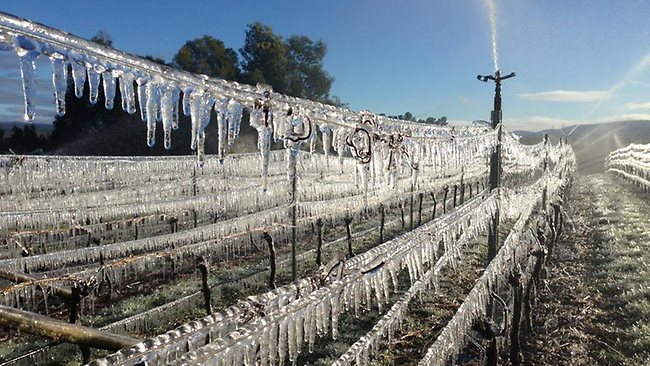Frost injury occurs when green tissues become dehydrated, causing loss of tissue function and recovery (see photo above). The critical temperature for frost injury at any given location depends on a complex interaction of plant and environmental factors. In practice, -2°C is often selected as the threshold temperature for injury, meaning that frost protection, if used, should be commenced well before the temperature falls this low.
'An abundance of secondary shoots can offer a degree of yield compensation'When the primary bud and emerging shoot are injured, a secondary shoot may emerge from a secondary bud next to the damaged primary bud (more on anatomy here). Secondary shoots are less fruitful than shoots from primary buds; however, an abundance of these shoots can offer a degree of yield compensation.
'The probability of fruit production was 69% for an injured node'In a study reported this year (here), we assessed 869 nodes of Pinot Noir, each producing one or more shoots, in four Tasmanian vineyards after lows of -2.9 to -4.5°C. Most nodes were at woolly bud stage when injured. An injured node was more likely to have two or more shoots and less likely to produce fruit: the probability of fruit production was 69% for an injured node and 81% for a healthy node.
In terms of yield, total bunch mass was similar for healthy and injured nodes, indicating yield compensation through the production of multiple but less fruitful shoots per node. In a season with poor fruitset, we simulated the effect of 100% injured nodes and found that there would be 200g less fruit per linear metre than if all nodes were healthy. This yield loss corresponds to 0.61 tonne per hectare on a spacing of 2.5m x 1.25m and vertical positioning of shoots.
Another aspect of frost injury is that later emergence of secondary shoots may have follow on effects such as a later flowering period or lag in fruit ripening relative to vines with no frost injury. In our study, ‘near flowering’ scores for modified Eichorn–Lorenz growth stage were 19 and 17 for primary and secondary-shoot nodes, respectively. For reference, E-L stage 18 is when the flower caps are still in place and fading from green.
Two of the vineyards studied applied overhead irrigation for frost protection yet still suffered frost injury. A small amount of latent heat is released when water freezes (see photo below); therefore, a constant supply of water is needed to coat grapevine buds and shoots and to raise the temperature of grapevine tissues. Moreover, the timing of overhead irrigation (start and stop times) is worth getting right when water is expensive.

The severity of frost injury was spatially variable but there were no discernible spatial patterns or visible ‘frost lines’ at the study sites, despite one of the vineyards having a distinct slope. The irrigation system was possibly near its limit of effectiveness when air temperature was close to -5°C. Other possibilities include blockages in individual sprinklers, loss of water pressure, and/or lateral airflows distorting water spray patterns.
Frost fans or helicopters are another way to protect vines from injury; however, effectiveness depends on the structure of the air inversion layer such that warm air is mixed with colder air to raise the temperature sufficiently. Real-time and site-specific temperature observations can help direct the helicopter pilot to the most critical vine blocks first.
‘Do nothing’ is also a valid decision‘Do nothing’ is also a valid decision if it is likely to have the least impact on vineyard profitability and sustainability. Even so, a relatively cheap option is to manage radiation exchange through vineyard floor management and/or a site modification to alter cold air drainage (see more here).
Reliable prediction of frost injury incidence at any given location remains elusive due to the few observations reported to date. Standard assessment methods, as proposed in our paper, will help build the data set for future modelling linked to high resolution and real-time maps of crop and atmospheric conditions.
For now, intimate site knowledge and loose rules-of-thumb inform the best solutions. Sleep on it!
Dr Kathy Evans is a senior research fellow at the Tasmanian Institute of Agriculture, University of Tasmania. This frost research was done opportunistically within a broader programme towards improved crop protection.


.jpg)









.png)






